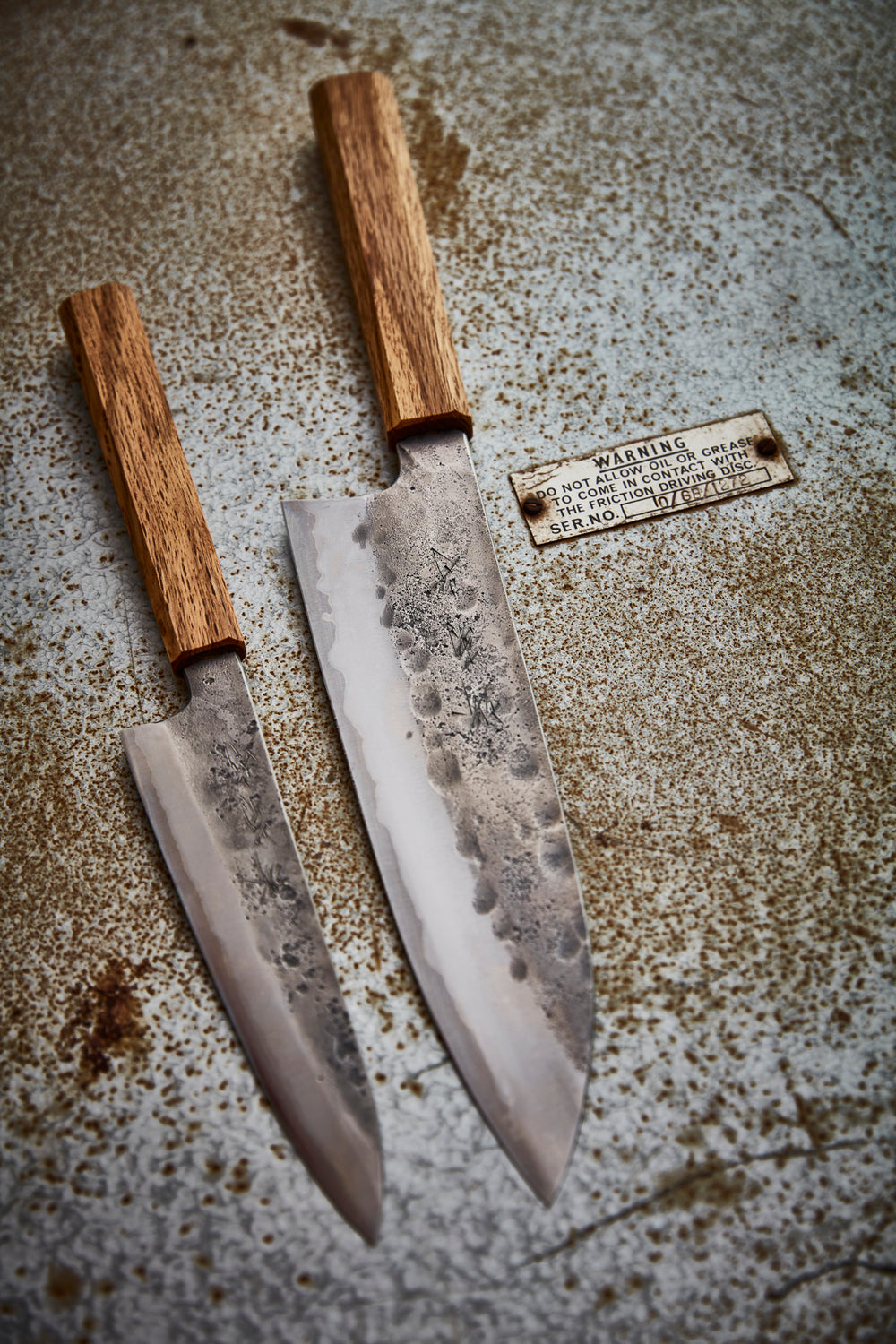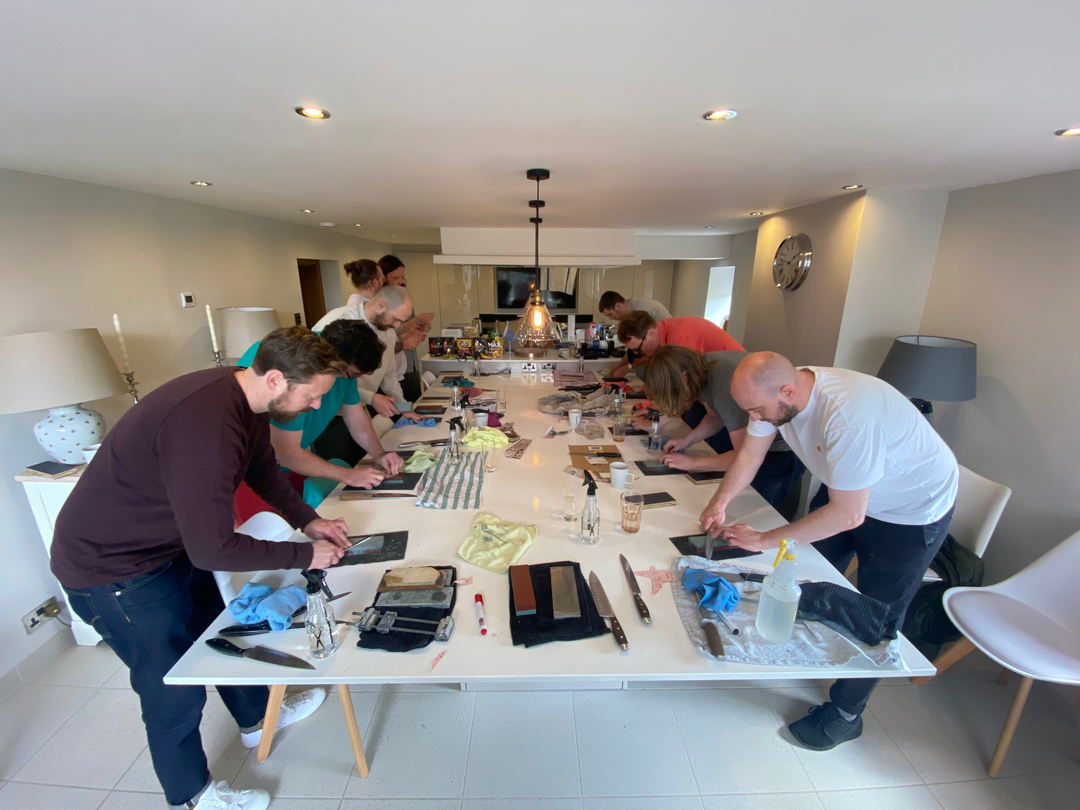Japanese Knives
Japanese Knives
How are Japanese knives made?
Japanese knife production generally falls within two categories, factory-made and handmade Japanese (blacksmith made) knives.
Factory-made
As you would expect, factory-made knives are produced on a larger scale with the use of mechanised operations, the factory will cut a knife shape from a sheet of metal before heat- treating, tempering, and grinding the bevels, sharpening, handling and branding.
Blacksmith made
The tradition and skill of a blacksmith in Japan is a hands-on affair, taking place in a hot, dusty forge. The smith will forge raw materials, possibly creating traditional Damascus pattern welded steel or San Mai/Ni Mai layered steel, before hammering into the rough shape of a knife, then grinding, handling, sharpening and finishing.
This ancient skill takes years to master and this is reflected in the price of the finished blade.
On the whole, a Japanese knife is of excellent quality, whether factory-made or blacksmith made, and whilst you can expect to pay more for a handmade blade as soon as you begin to put it to use you will be able to see why.
How do you sharpen Japanese knives?
They are best sharpened using traditional whetstones, it may be possible to sharpen with other methods and you may achieve satisfactory results but we would advise strong caution and never recommend the use of high speed grinders or cheap “pull through” sharpeners on a thinly ground chef's knife. If you’ve treated yourself to a good knife then allow it to perform at its best and sharpen it right:- or get someone to do it for you. On our Community Cutlery website we have a range of whetstones capable of doing a great on your knives, but feel free to get in touch if you don’t think you’re up to the job, we specialise in the sharpening of Japanese knives and would be happy to help.
Why are Japanese knives so expensive?
Whilst it’s not true that all Japanese knives are very expensive, it can be true of some.
Comparatively speaking a factory-made Japanese knives can fall into a similar price range to high-end European knives factory-made knife.
Handmade knives (whether Japanese or not) are always more expensive, they’re made slowly, by hand, in small batches, with age old techniques to exacting standards. Expensive, high quality materials are used and the worldwide demand for these products, produced by very small teams, is overwhelming. Lots of Japanese knife makers have closed their business to new customers and existing customers may have to wait for over a year to receive orders. All these factors contribute to the retail price as well as the fact that after all this, they still need to be shipped from Japan!
Whilst Japanese knives, particularly handmade ones are a premium product, we know from our own experience and that of our customers that they’re worth it, using a quality Japanese knife is a whole new experience, they’re not only enjoyable to use but they look great and yield exceptional results.
Do Japanese knives rust?
A Japanese knife can rust, but regardless of where they’re from, carbon steel knives can rust if not cared for correctly. At this point it’s worth noting that not all Japanese knives are carbon steel. It is a popular choice for Japanese knife makers but it is possible to get stainless Japanese knives, like this.
Carbon steel is a favoured choice of smiths and knife makers around the world as it has a greater ability to take a sharp edge and retain it for longer. For this privilege we need to take extra care with the maintenance of our carbon steel knife, it is a reactive metal and If left wet, it will rust.
Carbon steel knives can be expected to build up a patina, it is normal and to be treasured. It occurs when the metal comes into contact with acids in food and leaves characteristic dark blue-grey patterns on the surface. Patina can be removed but does provide the blade with some protection from rust. Once used a knife should immediately be washed and dried thoroughly before being stored carefully, and it should never be placed in a dishwasher!
Educating our customers about using carbon steel is important, so now we've got that out the way, it's also worth saying that looking after a knife like this is not hard, not at all, it just takes the tiniest amount of discipline and it's absolutely worth it.
Are Japanese knives the best?
This is a question we get asked a lot and one which is really impossible for us to answer on your behalf, choice should always be governed by personal preference (and of course budget) and what works for you may not necessarily work for us. Japanese knives have their pros and cons, just like western knives do, but in our opinion, Japanese blacksmiths do produce some of the best knives in the world, but that being said, there are many independent knife makers outside of Japan who produced knives using the same techniques and to the same profiles and standards as the Japanese tradition, and their work should be given the respect it deserves.
What makes Japanese knives so good?
Japanese knives have evolved to have a blade profile which lends itself to superior cutting action, typically they’re thinly ground, making them thin behind the cutting edge, which essentially allows the sharper edge to remain in contact with the food whilst cutting, rather than cracking or wedging it apart as a thicker knife would.
Combine this with a knife made from high-quality carbon steel, capable of taking a better shaper edge and remaining sharper for longer and you have a tool with exceptional functionality.
Which Japanese knife do I need?
We often recommend to our customers that they primarily need a larger, chef-style Japanese kitchen knife to take care of most of the jobs and a smaller pairing style knife for the more detailed tasks. So if you were looking to buy Japanese kitchen knives to fill these roles we would highly recommend you look at a Gyuto or a Santoku to fill the larger chef's knife role and a Petty to fill the paring knife roll.
Various types of knives and their performance in the kitchen
A Santoku is it traditional all-round Japanese knife for the house and a Gyuto is the Japanese answer to the western chef knife, both are excellent all-round kitchen knives, the petty is a smaller knife designed for taking care of finer tasks, once you have filled these spaces in your knife roll you can make an assessment, if you find you need a more specialist knife then there is a veritable myriad of available:- a Deba for butchering fish, a Sujihiki for slicing meat, a Usuba for vegetable prep and the list goes on.
Are Japanese knives worth it?
In our opinion yes, they are worth it, Japanese knives perform exceptionally well, they are a joy to use, they look great we feel that they increase pleasure and enjoyment derived from cooking. But that’s just us, preference is in its nature personal, we always advise you try to get to the shop to handle the knives you’re interested in before you make the commitment.
Are Japanese knives single bevel?
Some Japanese chef knives are single bevel but not all are single bevel blades. The more traditional Japanese knives like Deba, Yanagi or Usuba are single bevel, but knives like Gyuto, Petty or Santoku, which are more general use knives are usually double bevel. Sometimes Japanese double bevel knives can be sharpened with an uneven bevel, for example 70/30 or 60/40 but often double bevel knives are sharpened with an even 50/50 bevel.
Are Japanese knives full tang?
Japanese knives with traditional Japanese or "wa" handles are not full tang but Japanese knives with western style "yo" handles are usually full tang.
Do Japanese knives have a bolster?
Traditional Japanese knives do not have a bolster although Japanese knives with a western- style "yo" handle often have a half bolster.
How do I clean Japanese knives?
We recommend cleaning with mild soap and water and drying thoroughly after use to avoid rust formation.
How do I store Japanese knives?
It’s very important from a safety point of view that you do not store knives in a drawer where they could be grabbed by mistake. If they are stored in a drawer would you recommend storing them in the box they came in or with a blade sheath or Saya attached.
Ideally we would recommend storing knives on a magnetic wall block but we do appreciate that not everybody has space for or the need for a magnetic wall block. However you choose to store your knife make sure that it cannot be grabbed, it is out of reach of children and it is not somewhere that its blade can be damaged by knocking against other items.
Can you hone Japanese knives?
Yes, and we recommend adopting a routine of regular honing or stropping to keep Japanese knives at their best. By adopting this practice before every use you will keep your blade aligned and greatly reduce the need for sharpening on such a regular basis.
We recommend using a high grit ceramic hone or our preference is to use a strop, you can find instructional videos about how to use both of these items on our Instagram page @communitycutlery.
How do I know which Japanese nice to buy?
We recommend the best way is to visit your local knife shop and get familiar with the different styles and blades in stock to find the perfect knife for you. Chat with the staff, or with someone else who is knowledgeable and ask questions. Find out which handle style you like, which style you like the look of and make it a considered decision.
Here at Community Cutlery we stock a variety of brands at various prices. If you like anything you see on our website but you can’t make it to the shop, please send us a message. We want the customer to have the perfect knife for them so we will gladly record some videos showing you the various features of the knives you’re interested in, giving you a better idea of what they are like up close.




